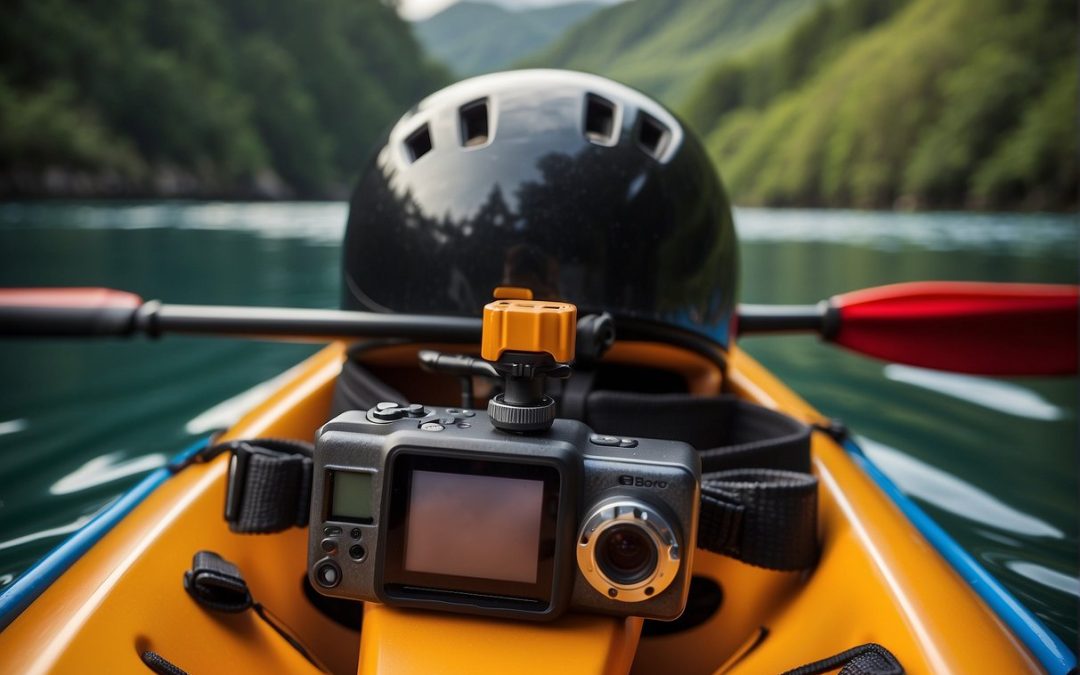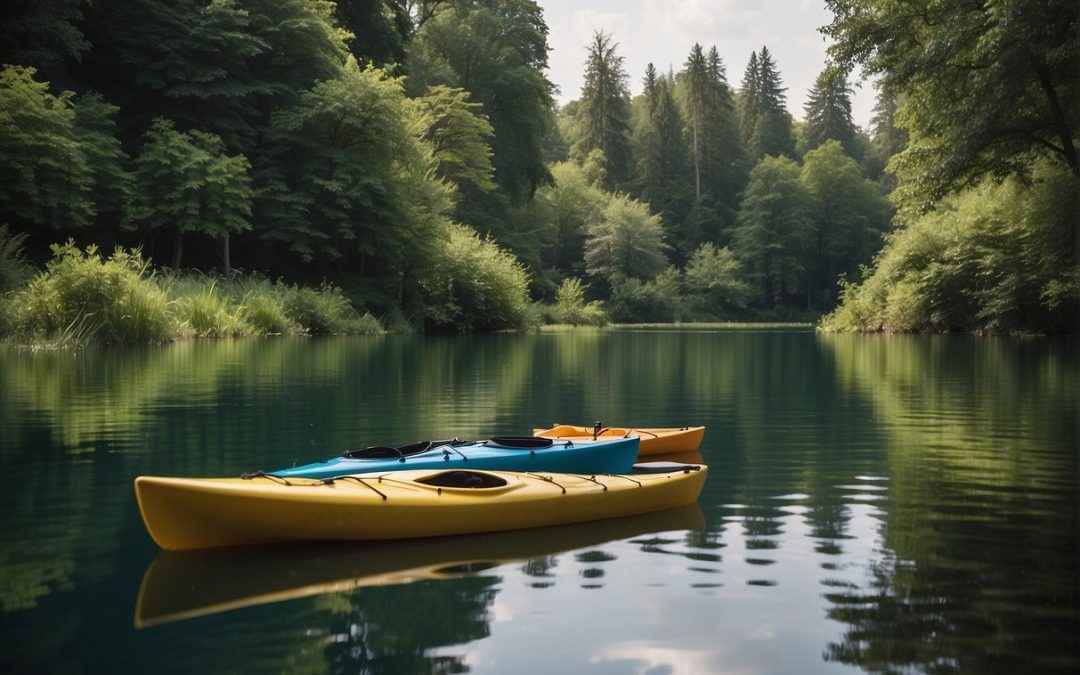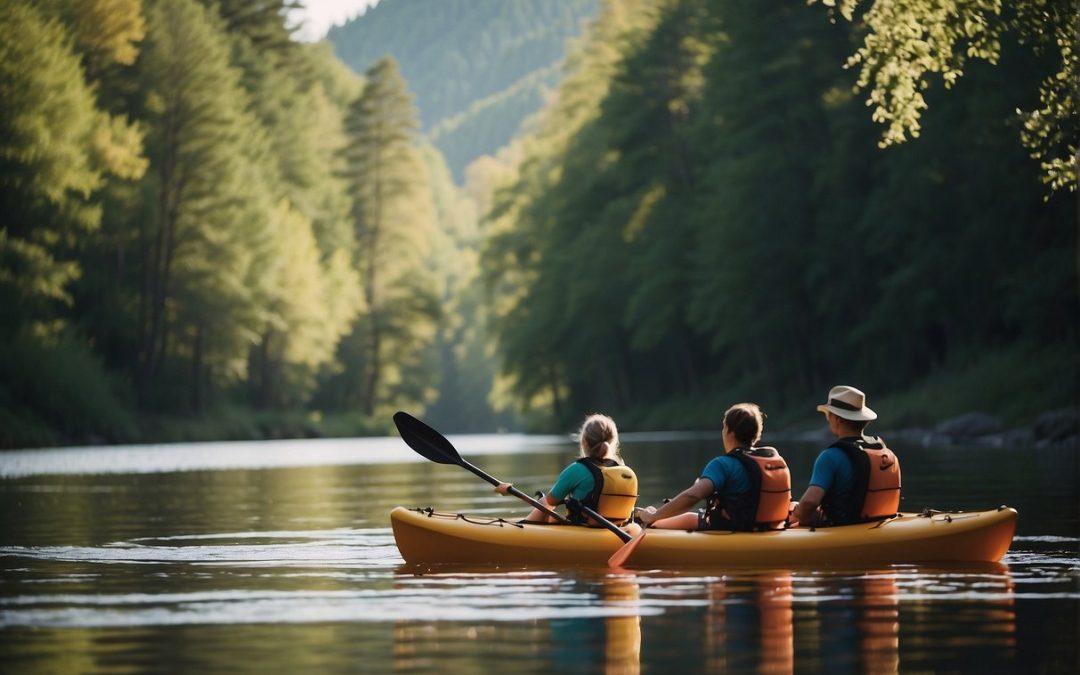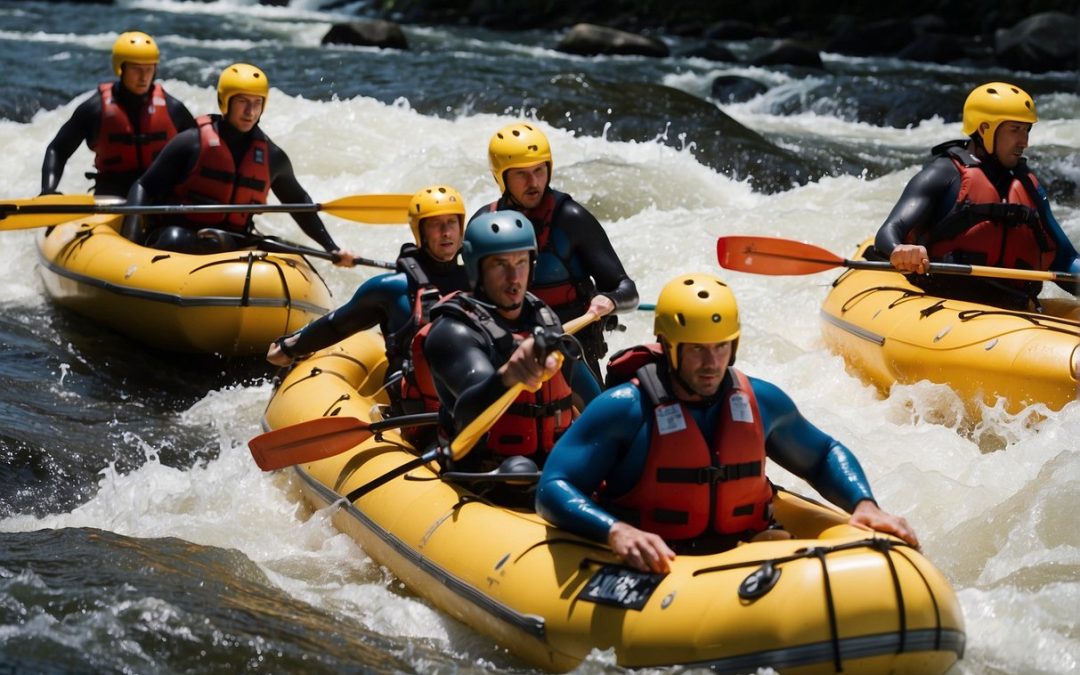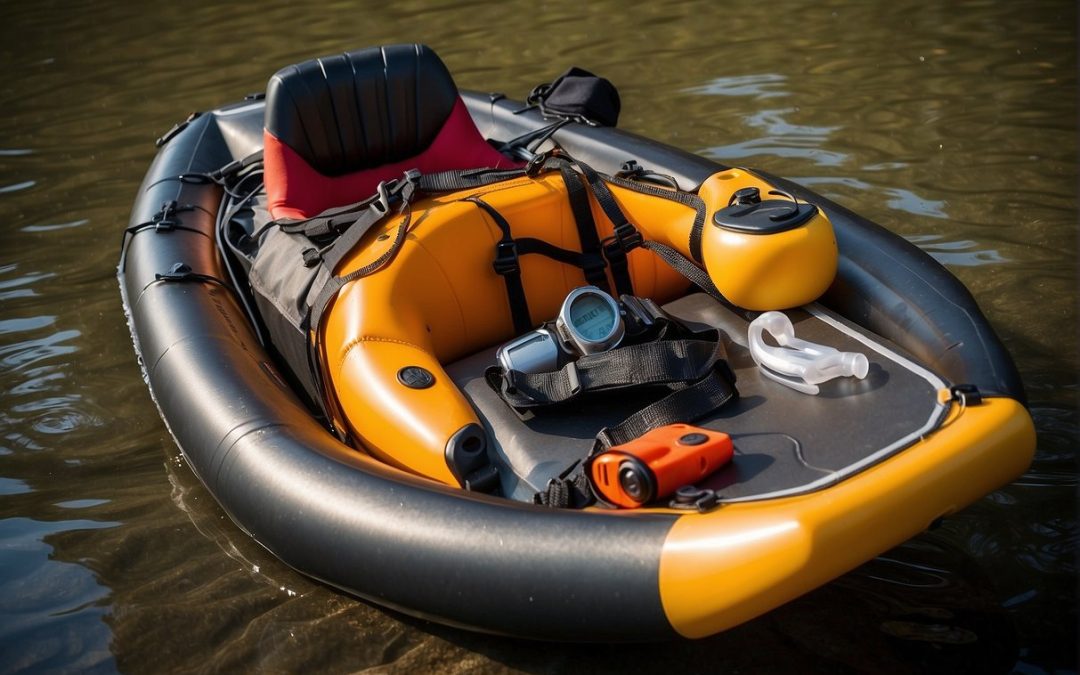Aquatic habitats kayaking offers an immersive and unique experience that allows paddlers to explore diverse water bodies while encountering various wildlife and aquatic organisms. Paddling through nature’s waterways provides a sense of adventure and contributes to a deeper understanding of different aquatic environments, including marine and freshwater ecosystems. As kayaking is a versatile sport, it caters to the interests of recreational enthusiasts and competitive athletes, emphasizing the importance of safety, proper techniques, and preparedness to ensure a positive and memorable experience.
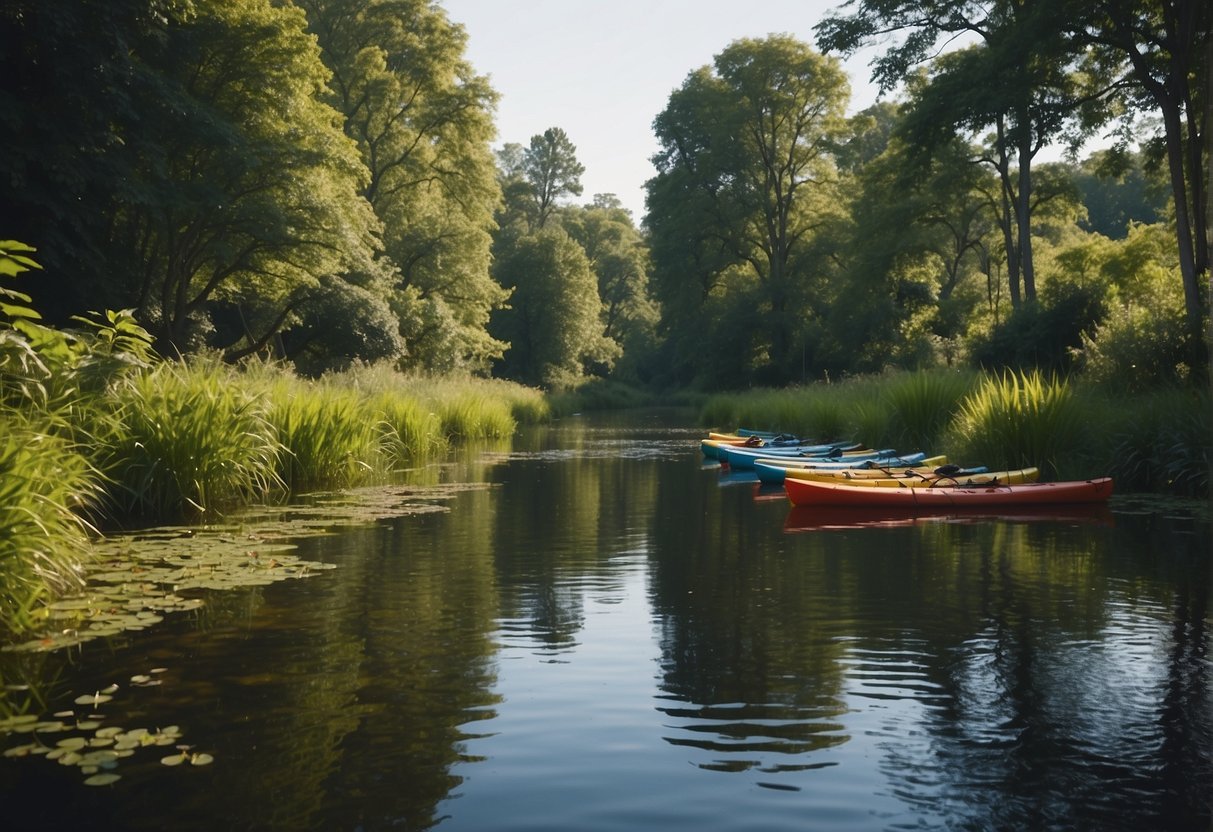
Learning about the unique characteristics of various aquatic ecosystems and their inhabitants is crucial to get the most out of kayaking of aquatic habitats. By mastering navigational skills, understanding the impact of weather on water conditions, and adhering to kayaking etiquette and regulations, paddlers can contribute to preserving the health of these fragile habitats. Additionally, being prepared to deal with challenging situations while exploring diverse water bodies ensures the well-being of both the kayaker and the aquatic environment in which they are paddling.
Key Takeaways
- Aquatic habitat kayaking encourages the exploration of diverse water bodies and interaction with various wildlife.
- Safety, preparedness, and mastering navigational skills are essential for a positive kayaking experience.
- Preserving aquatic ecosystem health and adhering to regulations is crucial when paddling in different environments.
The Basics of Kayaking
Choosing the Right Kayak
The first step in learning the basics of kayaking is selecting the appropriate kayak. There are different types of kayaks available, each designed for specific purposes:
- Recreational Kayaks: Ideal for calm waters, such as lakes and slow-moving rivers.
- Touring Kayaks: Designed for more extended expeditions and rougher water conditions.
- Whitewater Kayaks: Suitable for navigating through rapids and swift currents.
To begin with, renting a kayak is an excellent idea to understand which type suits your needs and preferences.
Kayaking Gear
Aside from the kayak itself, you will need essential gear to ensure a safe and enjoyable kayaking experience:
- Personal Flotation Device (PFD): It’s crucial to wear a personal flotation device for safety in case of accidental capsizing. Make sure the PFD fits comfortably and allows for freedom of movement.
- Paddle: Choose a paddle that matches your height and the width of your kayak. Paddles come in various materials, such as aluminum, fiberglass, and carbon fiber.
- Spray Skirt: A spray skirt prevents water from entering the cockpit of your kayak, which helps maintain balance during your time on the water.
Balance and Paddling Techniques
Mastering balance and paddling techniques are essential skills for beginners. According to the beginner’s guide to kayaking, follow these simple steps for successful paddling:
- Hold the paddle firmly with both hands, ensuring your knuckles align with the paddle’s blades.
- Maintain proper posture by sitting upright and positioning your feet on the footpegs.
- Use torso rotation by engaging your upper body, not just your arms, for more efficient and powerful strokes.
- Practice different strokes such as forward, reverse, sweep, and draw to help you maneuver your kayak.
Remember to prioritize safety and build your skills through practice to become more confident in your kayaking abilities.
Safety and Preparedness

PFD and Safety Equipment
Wearing a personal flotation device (PFD) is essential for maintaining safety while kayaking in aquatic habitats. Select a PFD that fits comfortably and ensures adequate buoyancy. In addition to a PFD, carrying essential safety gear such as a whistle, paddle float, and bilge pump can enhance your preparedness for unexpected situations. Always wear a helmet when kayaking in rough waters or when navigating obstacles. It is crucial to familiarize yourself with the proper use and storage of safety equipment to maximize efficiency.
Emergency Procedures
Being prepared for emergencies is vital when exploring aquatic habitats. Firstly, ensure you have a well-stocked first aid kit on board and know how to use the items in it. Secondly, communicate your planned route and estimated return time to friends or family before going on a kayaking trip.
Understanding basic emergency procedures, such as self-rescue techniques, can significantly improve safety. In the event of a capsize, try to perform a wet exit by releasing the spray skirt and pushing yourself out of the kayak. After re-entering your kayak, use a bilge pump or sponge to remove excess water. Additionally, having a buddy system and knowing how to perform assisted rescues can contribute to overall group safety.
Understanding Weather and Water Conditions
Knowing weather patterns and water conditions is crucial for a safe kayaking experience. Always check the weather forecast and water temperature before setting off. Be aware of the dangers of strong currents, tidal changes, and fast-flowing rivers. Adverse weather conditions, such as strong winds and heavy rain, can impact visibility, making navigation difficult and increasing the risk of accidents.
Understanding the signs indicating changing weather and water conditions, such as dark clouds or sudden changes in wind direction and speed, is essential. Continuously monitor the surroundings for any indications of potential hazards and adjust your plans accordingly.
By following these guidelines on safety, preparedness, and understanding water conditions, you can enhance your kayaking experience in aquatic habitats, minimizing risks while exploring and enjoying nature’s diverse waterways.
Understanding Aquatic Habitats
Aquatic Biome Fundamentals
Aquatic habitats, whether marine or freshwater, are crucial to sustaining life on Earth. The aquatic biome is the largest of all biomes, covering approximately 75 percent of the planet’s surface. This biome’s major water sources include oceans, lakes, rivers, ponds, streams, and wetlands. Typically, freshwater habitats contain less than 1 percent salt, while marine habitats exhibit higher salt concentrations.
While exploring aquatic habitats, it’s essential to consider the various physical and chemical components at play. Such factors include the geomorphic setting, climate patterns, watershed conditions, and disturbance regimes. These components contribute to the complexity of aquatic habitats, ultimately shaping the ecosystems that thrive within them.
Diversity of Aquatic Ecosystems
The wide range of aquatic ecosystems across our planet is astonishing. The diversity in these environments, from coral reefs and oyster beds to salt marshes and mangroves, supports countless plant and animal species. The aquatic habitats can be divided into two main types: marine and freshwater ecosystems, each with their respective organisms.
Marine ecosystems: Predominantly found in oceanic regions, these ecosystems are home to various life forms specifically adapted to high salt concentrations. Examples include coral reefs, open ocean habitats, and seagrass beds.
Freshwater ecosystems: These habitats comprise only a tiny fraction of Earth’s water resources but support many species. Encompassing lakes, rivers, ponds, streams, and wetlands, they are characterized by lower salt content, enabling the existence of numerous freshwater organisms.
In addition to their ecological importance, the world’s aquatic habitats provide ample opportunities for recreational activities like kayaking, allowing us to experience and appreciate these diverse ecosystems intimately. Understanding the complex dynamics of marine habitats is vital for their conservation and preservation, ensuring a thriving future for the various species that call these environments home.
Marine and Freshwater Environments
Oceanic and Coastal Kayaking
Oceanic and coastal kayaking offers adventure, exploring diverse marine ecosystems with high dissolved salt levels, such as estuaries and oceans. Kayakers should know the challenges and precautions necessary for these environments, like tides, currents, and potential hazards such as marine life and changing weather conditions.
In the vast expanse of the open ocean, kayakers can encounter diverse species of marine life, ranging from colorful fish populations to larger marine mammals such as whales and dolphins. Coastal kayaking allows for exploring various habitats, including rocky shores, sandy beaches, and lush estuaries – unique environments where fresh and saltwater mix, supporting an array of flora and fauna.
Inland Lakes and Rivers
On the other hand, inland lakes and rivers offer a serene setting for kayaking enthusiasts, immersing them in diverse freshwater ecosystems. These habitats exhibit low salt concentrations, providing opportunities to explore calm and relaxing environments, such as tranquil lakes and gently flowing streams.
Kayakers paddling through freshwater habitats can observe distinctive plant and animal species adapted to these particular environments. For instance, freshwater bodies may be home to various bird species, aquatic mammals like otters, and many fish and other marine organisms.
Kayakers must be well-prepared when embarking on aquatic adventures in marine and freshwater habitats. By understanding the unique characteristics of each environment and taking necessary precautions, kayakers can ensure safe and unforgettable experiences in the diverse world of aquatic habitats.
Aquatic Ecosystem Health

Conservation Efforts
Conservation of aquatic ecosystems plays a crucial role in preserving various marine organisms’ biodiversity and natural habitats. Multiple approaches are implemented to protect these habitats, from restoration projects to legislative actions. For instance, the U.S. Geological Survey researches shallow lake management to enhance waterbird habitat during fall migration.
Critical components of conservation efforts include:
- Habitat restoration: Re-establishment of lost or degraded habitats to maintain the desired level of biodiversity.
- Education and awareness: Informing the public and stakeholders about the importance of aquatic ecosystems in supporting diverse marine organisms.
- Regulating human activities: Implementing restrictions and monitoring human activities to reduce their impact on aquatic habitats.
- Monitoring and evaluation: Continuous assessment of aquatic ecosystems and habitats to detect changes in biodiversity and health.
Impact of Human Activity
Human activities have vast and varied effects on aquatic habitats and the organisms living within them. These activities can cause changes in water quality, ecosystem functioning, and habitat availability for diverse species. Examples of such impacts include:
- Pollution: Contamination from industrial waste, agricultural runoff, and other sources can lead to decreased water quality, harmful algal blooms, and eutrophication. These changes affect the health of aquatic organisms, including fish, plants, and bacteria.
- Land use: Urbanization, agriculture, and deforestation can lead to habitat loss, fragmentation, and degradation, resulting in reduced biodiversity and disrupted ecosystem functioning.
- Over-exploitation: Excessive fishing, mining, or timber harvesting can deplete resources and reduce the available habitat for aquatic species.
Efforts to mitigate the impact of human activity on aquatic ecosystems often focus on sustainable management practices like integrated water resources management, which involves coordination among various stakeholders to balance the needs of humans and the environment. Additionally, conservation initiatives aiming to preserve or restore aquatic habitats can be crucial in ensuring these vital ecosystems’ long-term health and diversity.
Techniques for Efficient Paddling
Essential Paddling Strokes
To become confident and knowledgeable in aquatic habitats kayaking, paddlers must master some keystrokes. The forward stroke propels the kayak forward, while the sweep stroke is essential for turning the boat. Additionally, the draw stroke helps move the kayak sideways, and the reverse stroke aids in stopping and moving backward. Proper paddle grip and blade angles are crucial for all these movements. For example, hold your paddle with a slight bend in your elbows and angle your blades at 90 degrees for maximum power in each stroke1.
Efficiency in paddling also involves the catch phase and the power phase. During the catch phase, the paddle blade enters the water, and while in the power phase, that blade propels the kayak forward. Take advantage of both phases to generate maximum power and propulsion during each stroke.
Navigating Currents and Tides
Effective kayaking involves adapting your paddling techniques to the water conditions at various aquatic habitats. When kayaking in calm waters, steady and rhythmic strokes prove effective, while rapid currents and tides require more aggressive bracing and quick, responsive strokes3.
Understanding current speed and flow is vital for ensuring safety and success on the water. Familiarize yourself with the local buoy system and consult tide tables for information on the changing water conditions. Here are a few tips to assist with navigating various currents and tides effectively:
- Going with the flow: Paddle with the current as much as possible to save energy and decrease travel time.
- Eddy turns and peel-outs: Utilize eddies or calm areas behind obstacles in the water to enter and exit the primary current efficiently.
- Low brace: Use the soft brace technique to maintain stability and prevent capsizing when encountering strong currents and waves4.
Incorporate these efficient paddling techniques and awareness of currents and tides to enhance your aquatic habitats’ kayaking experience. Choose calm waters for initial outings, ensure appropriate safety gear, and enjoy the adventure of exploring various water conditions.
Footnotes
Exploring Diverse Water Bodies
Kayaking in Ponds and Wetlands
Ponds and wetlands are freshwater habitats that provide kayakers with a unique opportunity to experience various flora and fauna. Ponds, typically small bodies of water, often possess a vibrant ecosystem – they can be home to more than just fish and support birds, amphibians, and insects. On the other hand, wetlands are areas where water covers the soil or is present either at or near the soil’s surface for part of the year. As a result, wetlands support a diverse range of aquatic plant life, such as water lilies, sedges, and rushes1.
While kayaking in these ecosystems, being mindful of your surroundings and the delicate balance of nature is imperative. Avoid disturbing the wildlife, and be respectful of protected areas. The unique charm of ponds and wetlands will reveal itself to those willing to take their time and observe the wonders around them.
Adventures in Estuaries and Streams
Estuaries are where rivers meet the sea, forming brackish water with mixed salinity levels2. They are known for their vibrant biodiversity and astounding beauty. Kayaking in estuaries offers an adventure like no other – a chance to witness the confluence of both freshwater and marine ecosystems.
On the other hand, streams are small, flowing bodies of water that may form tributaries or pour directly into an ocean3. Kayaking in streams can be a thrilling experience due to the changing water velocity and the potential for navigating small rapids. It also allows for an intimate exploration of the surrounding flora and fauna in an ever-changing landscape.
When embarking on a kayaking adventure in estuaries and streams, knowing the tide schedules and local regulations is crucial. Proper safety precautions and understanding one’s kayaking abilities can lead to a memorable and fulfilling experience.
Footnotes
Wildlife and Aquatic Organisms
Fish and Invertebrates
Aquatic habitats kayaking offers an opportunity to observe a diverse range of fish and invertebrate species. In both marine and freshwater habitats, you can find a variety of fish, ranging from tiny minnows to large predatory species such as sharks or pike. Invertebrates such as mollusks (e.g., clams, mussels, octopus, and squid) and arthropods (e.g., crabs, lobsters, shrimp, and crayfish) are also abundant in these ecosystems 1.
In some locations, you may encounter unique species, like certain mollusks limited to specific habitats such as freshwater streams, rivers, and lakes. Other invertebrates, like insects, play essential roles in these ecosystems, serving as both food sources for larger organisms and as decomposers, breaking down dead plant and animal matter.
Plankton and the Food Chain
Plankton are vital to sustaining life in aquatic habitats, serving as the base of the food chain. Comprised of two main groups, phytoplankton (tiny plant-like organisms) and zooplankton (microscopic animal-like organisms), they drift with currents and are a primary food source for numerous aquatic species 2.
Phytoplankton produce energy through photosynthesis and are consumed by zooplankton, which, in turn, are an essential food source for larger organisms like fish and invertebrates. Bacteria also play a crucial role in breaking down organic material and recycling nutrients to support phytoplankton growth.
As kayakers paddle through these ecosystems, they may observe an intricate balance between predator and prey, witnessing the interdependence of various organisms within the food chain. By understanding the complex relationships in aquatic habitats, kayakers can better appreciate the importance of conserving and respecting these delicate environments.
Footnotes
Navigational Skills
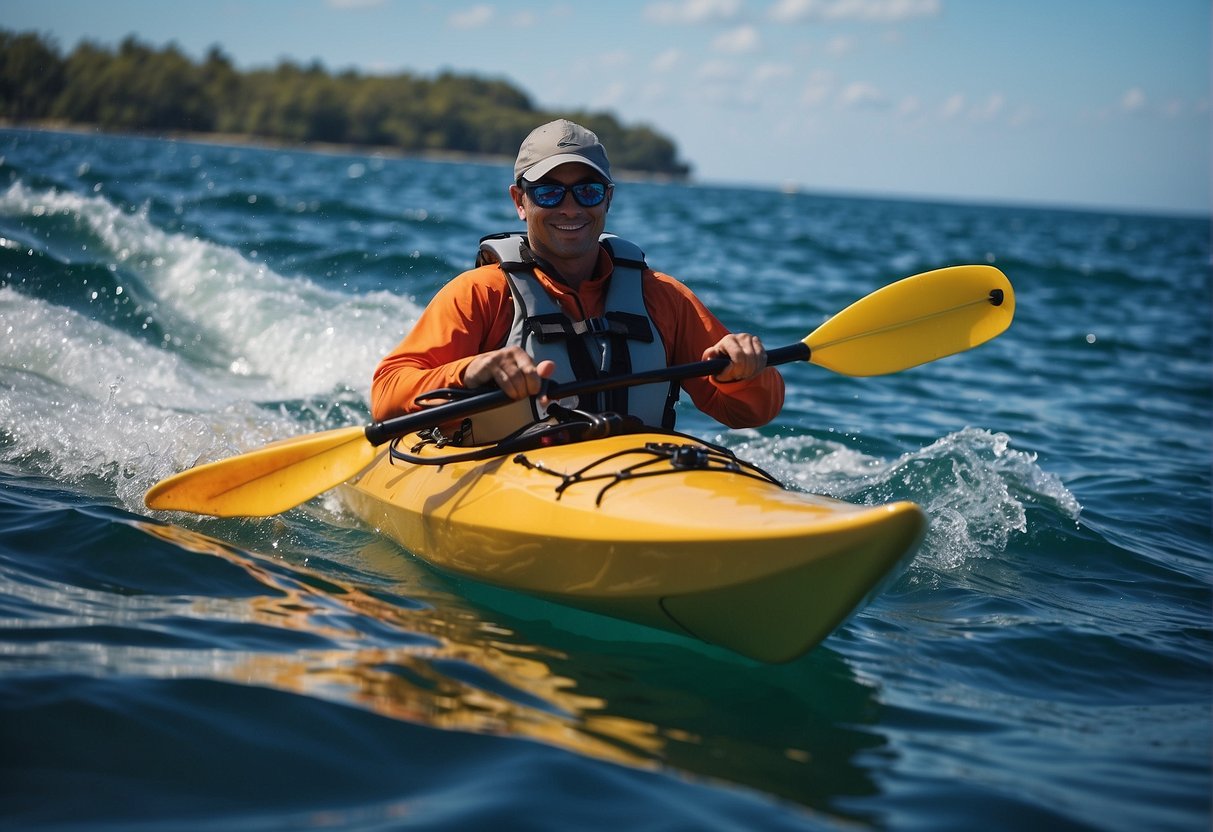
Reading Water and Varied Conditions
When kayaking in aquatic habitats, it’s crucial to understand the water conditions to navigate safely and efficiently. One of the most critical aspects of reading water is recognizing currents. Water currents can vary greatly, often influenced by weather, tides, and even underwater topography like the depth of the water.
It’s essential to monitor changes in water flow and identify potential hazards to prevent getting caught in dangerous situations. For example, when facing solid currents, you may need to angle your kayak into the flow to maintain control and avoid being pushed off course. Similarly, differing weather conditions can significantly impact water’s behavior, such as creating choppy waves or sudden downpours affecting visibility.
Understanding Eddies and Banks
In addition to currents, other features in aquatic habitats may impact navigation, such as eddies and banks. An eddy is an area of swirling water created by disturbances in the flow, usually found near obstacles like rocks, boulders, or bends in the river. On the other hand, banks are the edges of a body of water where land meets water.
Eddies can provide a calm area for paddlers to rest, regroup or plan their next move, but maneuvering in and out of them can be tricky. When entering an eddy, aim to do so at an angle, and brace yourself using your paddle as the swirl may unsettle the kayak momentarily. When leaving an eddy, it’s important to build up sufficient speed and angle your kayak towards the main flow to avoid being pushed back into the eddy or toward the bank.
Knowing how to identify and navigate around banks is also crucial. They can pose hazards, such as submerged logs or sudden shallowness, which can cause your kayak to get stuck or even flip. Being vigilant, maintaining a safe distance from banks, and adjusting your paddling techniques can help you safely navigate these obstacles.
By mastering the skills of reading water, understanding varying conditions, and recognizing eddies and banks, you’ll be better equipped to paddle confidently and safely through diverse aquatic habitats.
Weather Influence on Kayaking

Sunlight and Temperature Impact
Sunlight plays a significant role in the kayaking experience. It not only affects visibility but also influences water temperature. Warmer water is generally more comfortable for kayakers, as it allows for longer excursions and increased chances of observing aquatic habitats.
Temperature also affects the nutrient availability in water. Warmer water encourages the growth of microorganisms and aquatic plants, which can result in higher nutrient levels and more opportunities to observe aquatic ecosystems.
As a kayaker, it’s essential to monitor sunlight and water temperature to maximize your understanding of the equatic habitat. Equapping yourself with protection against harmful UV rays through sunblock, sunglasses, and clothing is also necessary for a safe kayaking experience in sunlight.
Wind and Tides Dynamics
Wind and tides directly impact the kayaking experience, from paddling techniques to the level of difficulty one might encounter during the trip. Before setting out, it’s essential to check the wind and tide conditions to plan for a safer journey.
When kayaking in accordance with the direction of the wind, it becomes easier to paddle and maintain speed. However, paddling against the wind requires more energy and effort and can be quite challenging for beginners.
Tides also play a crucial role in shaping equatic habitats. Many marine species rely on tide fluxes to access essential nutrients, and unique ecosystems found in tidal zones offer fascinating glimpses into life beneath the waves.
To make the most of your kayaking adventure, familiarize yourself with the basic paddling techniques and be prepared to adapt to varying wind and tide conditions. Having a good understanding of weather patterns and their influence on equatic habitats can greatly enhance your kayaking experience.
Kayaking Etiquette and Regulations

Rules of the Water
When kayaking, it is essential to remember that paddlers share the water with other users, such as boaters and swimmers. To ensure a safe experience, there are several rules to follow. Always wear a personal flotation device (PFD) regardless of your swimming ability or boating expertise. Moreover, refrain from consuming alcohol while paddling as it impairs judgment and increases the risk of accidents.
Mastering basic paddling techniques and understanding navigation rules are crucial. For instance, always give right-of-way to larger vessels, and maintain a safe distance from shorelines and other watercraft to prevent collisions. Moreover, it is a kayak operator’s responsibility to know the kayaking rules and regulations specific to the region or water body they are paddling in, as these may differ across countries or states.
Environmental Regulations
To protect the delicate aquatic ecosystems and promote sustainable kayaking practices, adhering to environmental regulations is essential. Following the Leave No Trace principles is a great starting point for responsible kayaking. These guidelines emphasize respecting wildlife, minimizing waste, and avoiding disturbance to their habitats.
- Respect wildlife: Keep a safe distance from animals, do not feed them, and avoid making loud noises to prevent stress-induced behavior.
- Dispose of waste properly: Collect all trash, including food scraps, and dispose of them in designated trash or recycling containers.
- Avoid resource damage: Be mindful of your surrounding environment to prevent damage to essential habitats, such as marshes or wetlands. Paddle in designated waterways and refrain from trampling vegetation.
By following these guidelines and upholding the proper kayaking etiquette and regulations, kayakers can contribute to the conservation of the environment and preserve the natural beauty of aquatic habitats for future generations to enjoy.
Dealing with Challenging Situations

Capsizing Scenarios
Capsizing can happen to even the most experienced kayakers, so it is crucial to know how to handle such situations. When capsizing occurs, keep calm and remember the essential steps to regain control of the kayak. First, lean forward and push the bottom of the kayak with your paddle^4^. Next, release the protective spray skirt that’s attaching you to the kayak^4^. Thoroughly remove the skirt to ensure a safe exit from the kayak.
In the event of capsizing, it is crucial to know how to perform a wet exit. Wet exits are essential for self-rescue and require a systematic approach. Before attempting a wet exit, decide whether the kayak can be flipped upright, or if an exit is necessary^4^. To perform a successful wet exit, follow these steps:
- Tuck forward and place both hands on the edges of the cockpit coaming.
- Pull and release the spray skirt loop.
- Slide your hands along the sides of the cockpit as you pull your legs out.
- Carefully exit the kayak by kicking your legs free.
Knowing basic rescue techniques can significantly increase safety while kayaking. Always carry essential rescue gear, such as a bilge pump, paddle float, and throw bag, and practice using them before embarking on any paddling adventure.
Managing Obstacles and Portaging
Navigating obstacles is a critical skill for any kayaker. One common challenge is dealing with holes, or areas where fast-moving water flows over an obstruction, creating a hydraulic jump^5^. To safely navigate through holes, lean forward while paddling towards the hole, preventing the kayak from being pulled back by the recirculating water^5^.
Sometimes, obstacles such as fallen trees, rocks, or low head dams require portaging, the process of carrying your kayak around the obstruction. When portaging, follow these tips for safe and efficient handling:
- Scout: Before attempting a portage, scout the area to ensure a safe route. Look for hazards, like slippery rocks or hidden drop-offs, and choose the easiest path around the obstacle.
- Secure: Secure loose items in the kayak to prevent loss or damage during the portage.
- Lift: Properly lift the kayak to minimize strain on your body. Use proper form by bending your knees, maintaining a straight back, and lifting with your legs.
- Carry: Engage your core and hold the kayak close to your body during transport to make the portaging experience less strenuous.
By developing essential skills for managing challenging situations in aquatic habitats, kayakers can significantly improve their safety and enjoyment while exploring diverse waterways.
The Role of Ecosystem Elements

Photosynthesis and Decomposers
In aquatic habitats, photosynthesis plays a vital role in maintaining the overall health of the ecosystem. Phytoplankton and other vegetation are the primary producers, utilizing sunlight to convert carbon dioxide and water into oxygen and organic compounds. This process not only provides food for other organisms but also aids in maintaining oxygen levels in the water.
Decomposers, on the other hand, are responsible for breaking down dead organic matter, recycling nutrients back into the ecosystem. These organisms, including bacteria and fungi, are critical for the functioning of aquatic ecosystems, as they ensure a continuous supply of nutrients for other living organisms.
Siltation and Aquatic Vegetation
Siltation is the accumulation of fine particles, such as sediment and detritus, in aquatic habitats. This can be caused by natural processes or human activities, such as agriculture and construction. Siltation can significantly impact the health and dynamics of aquatic ecosystems. Notably, excessive siltation can cause a reduction in water quality, increased turbidity, and alterations to existing habitats.
Aquatic vegetation plays a crucial role in mitigating the effects of siltation. Plants, such as submerged, floating, and emergent vegetation, help stabilize sediment, reduce the speed of water flow, and provide a substrate for the establishment of other organisms. Furthermore, aquatic plants offer critical habitats for numerous native species, including invertebrates, fish, and birds.
In conclusion, the elements of aquatic ecosystems are intricate and interconnected. Photosynthesis, decomposers, siltation, and aquatic vegetation all play essential roles in maintaining ecosystem health. As kayakers, it is crucial to acknowledge and respect these delicate habitats while exploring nature’s beauty on the water.
Kayaking for Recreation and Sport
Recreational Kayaking
Recreational kayaking is a popular outdoor activity that offers a unique blend of fun, relaxation, and a closeness to nature. It provides a low-impact exercise that helps improve balance, coordination, and strength. Ideal for individuals and families alike, it can be easily enjoyed on various bodies of water such as rivers, lakes, and coastal regions, providing a sense of freedom and exploration.
There are different types of kayaks to choose from, with sit-inside and sit-on-top designs being most commonly used for recreational purposes. The main factors to consider when selecting a kayak for recreational use are stability, maneuverability, and comfort. Inflatable kayaks can be a great option for those with limited storage space or for travelers who want a portable option, while rigid kayaks provide better performance and durability for regular use source.
When kayaking, it’s essential to respect the aquatic habitats and follow sustainable practices, such as adhering to the “Leave No Trace” principles to help protect these fragile ecosystems source.
Competitive Paddling and Races
For those who crave a challenge and seek to transform their kayaking experience into a sport, competitive paddling and races offer an exciting opportunity to display skills and athleticism. Races vary in nature and can take place in open water, rivers, or lakes and require participants to navigate through multiple checkpoints or complete a designated course.
Competitive kayaking events can be categorized into the following disciplines:
- Slalom: A timed race through a series of gates placed on a whitewater rapid course.
- Sprint: Short-distance races on flat water, often ranging between 200 and 1000 meters.
- Marathon: Long-distance races, typically 20 km or more, on flat water or rivers with a series of portage points.
- Surf ski: Races on open water, featuring specially designed kayaks to handle waves and ocean conditions.
Competitive paddling demands a higher level of skill, fitness, and practice compared to recreational kayaking. It also requires specialized equipment designed for performance, such as lighter and more streamlined kayaks, in addition to appropriate safety gear source.
Frequently Asked Questions
What essential gear should a beginner kayaker invest in?
A beginner kayaker should invest in a high-quality personal flotation device (PFD), a suitable kayak paddle, a spray skirt, a helmet, and appropriate clothing. Additional items like a bilge pump, paddle float, and a whistle could also enhance safety and convenience.
What safety precautions are necessary for kayaking in different aquatic habitats?
Safety precautions include wearing a suitable PFD, checking weather conditions and water currents, avoiding hazardous areas, maintaining proper communication with fellow kayakers, and practicing self-rescue techniques. Aquatic habitats may require additional precautions, such as avoiding fragile wildlife areas and understanding local regulations.
How does one select the appropriate kayak for river exploration?
Selecting the right kayak for river exploration involves considering factors such as the type of water (flatwater or whitewater), the desired maneuverability, and one’s personal skill level. Touring kayaks are better suited for flatwater, while whitewater kayaks offer greater responsiveness and buoyancy in turbulent conditions.
Which techniques should a novice kayaker master for effective paddling and navigation?
Novice kayakers should master basic paddling techniques, like the forward stroke, sweep stroke, reverse stroke, and draw stroke. It’s also essential to learn the fundamentals of boat control, such as edging and leaning, and how to read water currents for effective navigation.
How does weather affect kayaking conditions in various aquatic environments?
Weather plays a significant role in kayaking conditions as it can influence water levels, currents, wave height, and visibility. Strong winds, heavy rainfall, and rapidly changing temperatures can create challenging and potentially dangerous conditions. Monitoring weather forecasts and understanding the specific requirements of various aquatic habitats help ensure a safe and enjoyable experience.
What are the key environmental considerations when kayaking in sensitive ecosystems?
Key environmental considerations include minimizing damage to vegetation and wildlife habitats, avoiding disturbing nesting sites or spawning areas, practicing ‘leave no trace’ principles, and using eco-friendly materials and equipment. Sustainable kayaking practices and adhering to local conservation guidelines also contribute to preserving aquatic ecosystems for future generations.
Conclusion
In summary, aquatic habitats kayaking offers enthusiasts the chance to explore diverse ecosystems while practicing an exciting water sport. To make the most of your experience, selecting the right kayak and mastering paddling techniques are crucial for both comfort and safety.
It’s important to engage in eco-friendly practices to protect aquatic ecosystems while kayaking. Adhering to sustainable kayaking guidelines like planning ahead, preparing, and understanding area regulations helps minimize your impact on the environment.
Remember, kayaking can disturb aquatic life. The hulls of kayaks can disrupt the habitats of fish and other creatures. Therefore, it’s essential to be mindful of avoiding pollution and sensitive areas during your kayaking adventures.
By following these recommendations and maintaining an environmentally-conscious mindset, you will enhance your aquatic habitat kayaking experience as well as contribute to the conservation of these precious ecosystems. Happy paddling!




